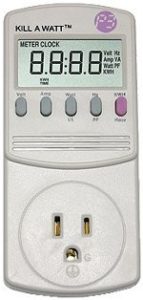 Some appliances come with yearly estimates for energy consumption, but many do not. Real life usage often varies from those estimates anyway. The Kill A Watt energy meter can be purchased or rented so you can get real, accurate information about how much energy an individual appliance or electronic device uses.
Some appliances come with yearly estimates for energy consumption, but many do not. Real life usage often varies from those estimates anyway. The Kill A Watt energy meter can be purchased or rented so you can get real, accurate information about how much energy an individual appliance or electronic device uses.
Here’s how to operate a Kill A Watt energy meter:
1. Unplug the appliance or electronic device you want to test. Be sure to turn it off before unplugging it, if applicable.
2. Plug the Kill A Watt meter into a wall outlet near your appliance.
3. Plug the appliance or device into the face of the Kill A Watt.
4. Power on the appliance or device if necessary. Leave it plugged into the Kill A Watt for an hour or longer. More time will provide more accurate information.
5. Read the Kill A Watt display to learn about the energy consumption:
- Volt: This should read approximately 120 volts, the U.S. standard for typical residential electrical outlets.
- Amp: Measures the electrical current flowing through the outlet.
- Watt: Indicates the amount of power used by the device per second.
- VA: Press the Watt button a second time to get a reading of the VA, the volts multiplied by the amperage.
- Hz: Most devices will generate 50 to 60 Hertz, which measures frequency.
- PF: Press the Hz button a second time to read the Power Factor, which is the wattage divided by the VA. This indicates the ratio of power being used to power being drawn.
- KWh/Hour: This tells you the total number of kilowatts used since the device was connected to the Kill-A-Watt. Press it a second time to see how long the device has been connected.
How to Read a Kill A Watt Meter
Now that you have all that info, what do the Kill A Watt numbers mean? Your main goal should be to determine how many kilowatt-hours your appliance or electronic uses while plugged in.
Refer to your utility bill to determine how much you typically pay for electricity. You can then multiply your electric rate by the KWh/hour figure for an appliance to see how much you pay to fuel that device. Remember to multiply by 24 hours, 7 days, 30 days, or 365 days to get different estimates for usage over time.
Has your Kill A Watt found an energy hog? Here’s what you can do:
- Unplug appliances that waste significant energy in standby mode.
- Repair or replace old appliances and electronics that are using exorbitant amounts of energy — they may be faulty or seriously outdated in terms of energy efficiency.
- Change your habits. Does one TV use far less energy than another TV in your home? Consider switching their locations so you use the more efficient one for your regular TV watching.
One more tip! You really do need to give the Kill A Watt plenty of time to collect data for certain appliances. You can get a good reading for a lamp’s light bulb within a few minutes, but items like refrigerators and computers will use different amounts of electricity over time. Leave those items plugged into the Kill A Watt for at least a few days so you have a good sample size of data.
Questions about how to learn from your Kill A Watt reading? Interested in making your home more energy efficient? Talk to your local electrician about reviewing your home or office’s electrical system and making any necessary upgrades.

